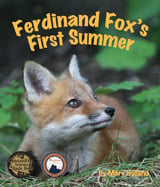Fecal Sac Removal

Congratulations to Leah Goat, the first of many Naturally Curious readers to correctly identify the puffy, white matter in the Mystery Photo as a bird’s butt. Avian parents have solved the diaper dilemma – they just do without. However, a nest filled with fecal matter is a health threat to nestlings as well as a magnet for predators and parasites. Many songbirds have evolved an efficient strategy to discourage this situation, one of which includes the cooperation of their young.
Some nestlings do everything in their power to enable their parents in their endeavor to maintain a feces-free nest. Within seconds of being fed they assume a position with their butts front and center at the opening of their nest cavity. Once in position, the chicks produce fecal matter from their cloaca that is enclosed in a clear or white membrane called a fecal sac. The parent immediately clasps the emerging sac in its beak and either eats it or flies off and drops it far enough away so as not to attract predators. Nestlings stop producing fecal sacs shortly before fledging. (Photos: Tree Swallow removing fecal sac of nestling)
Naturally Curious is supported by donations. If you choose to contribute, you may go to http://www.naturallycuriouswithmaryholland.wordpress.com and click on the yellow “donate” button.
Tree Swallow Nestlings Well Fed
 Tree Swallow parents begin feeding their four to seven nestlings as soon as they hatch, and they continue doing so until their young depart the nest and sometimes for several days afterwards. The adult carries food in its bill and places it directly into the open mouth of a begging nestling. The small insects gathered by the parent may be formed into a rounded ball, or bolus, which they hold in their mouth or throat (often not visible to an observer). Both parents feed the nestlings, together averaging about ten to twenty deliveries per hour. During periods of peak nestling demand, parents may feed as many as 6,000 to 7,000 insects in a single day. (Thanks to Jeannie Killam and Terry Ross for photo op.)
Tree Swallow parents begin feeding their four to seven nestlings as soon as they hatch, and they continue doing so until their young depart the nest and sometimes for several days afterwards. The adult carries food in its bill and places it directly into the open mouth of a begging nestling. The small insects gathered by the parent may be formed into a rounded ball, or bolus, which they hold in their mouth or throat (often not visible to an observer). Both parents feed the nestlings, together averaging about ten to twenty deliveries per hour. During periods of peak nestling demand, parents may feed as many as 6,000 to 7,000 insects in a single day. (Thanks to Jeannie Killam and Terry Ross for photo op.)
Naturally Curious is supported by donations. If you choose to contribute, you may go to http://www.naturallycuriouswithmaryholland.wordpress.com and click on the yellow “donate” button.
 In order to prevent disease or the passing on of parasites, it is a good idea to clean out nest boxes after they’ve been occupied. In the fall, after the last brood of eastern bluebirds or tree swallows has flown the coop, many nest box owners often clean them out in preparation for the next summer’s residents, but some wait until spring. This habit of waiting provides white-footed and deer mice (and occasionally flying squirrels) with a ready-made winter shelter and/or larder.
In order to prevent disease or the passing on of parasites, it is a good idea to clean out nest boxes after they’ve been occupied. In the fall, after the last brood of eastern bluebirds or tree swallows has flown the coop, many nest box owners often clean them out in preparation for the next summer’s residents, but some wait until spring. This habit of waiting provides white-footed and deer mice (and occasionally flying squirrels) with a ready-made winter shelter and/or larder.

















What Other Naturally Curious People Are Saying